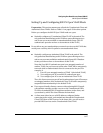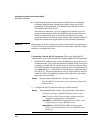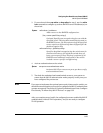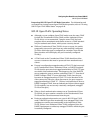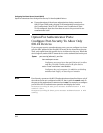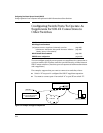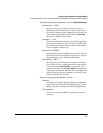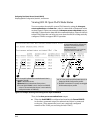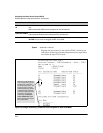
8-35
Configuring Port-Based Access Control (802.1X)
Configuring Switch Ports To Operate As Supplicants for 802.1X Connections to Other Switches
1. When port A1 on switch “A” is first connected to a port on switch “B”, or
if the ports are already connected and either switch reboots, port A1
begins sending start packets to port B5 on switch “B”.
• If, after the supplicant port sends the configured number of start
request packets, it does not receive a response, it assumes that switch
“B” is not 802.1X-aware, and transitions to the authenticated state. If
switch “B” is operating properly and is not 802.1X-aware, then the link
should begin functioning normally, but without 802.1X security.
• If, after sending one or more start request packets, port A1 receives
a request packet from port B5, then switch “B” is operating as an
802.1X authenticator. The supplicant port then sends a response/ID
packet. If switch “B” is configured for RADIUS authentication, it
forwards this request to a RADIUS server. If switch “B” is configured
for Local 802.1X authentication (page 8-19), the authenticator com-
pares the switch “A” response to its local username and password.
2. The RADIUS server then responds with an access challenge that switch
“B” forwards to port A1 on switch “A”.
3. Port A1 replies with a hash response based on its unique credentials.
Switch “B” forwards this response to the RADIUS server.
4. The RADIUS server then analyzes the response and sends either a “suc-
cess” or “failure” packet back through switch “B” to port A1.
• A “success” response unblocks port B5 to normal traffic from port A1.
• A “failure” response continues the block on port B5 and causes port
A1 to wait for the “held-time” period before trying again to achieve
authentication through port B5.
Note You can configure a switch port to operate as both a supplicant and an
authenticator at the same time.
Enabling a Switch Port To Operate as a Supplicant. You can configure
one or more switch ports to operate as supplicants for point-to-point links to
802.1X-aware ports on other switches. You must configure a port as a
supplicant before you can configure any supplicant-related parameters.
Syntax: [no] aaa port-access supplicant [ethernet] < port-list >
Configures a port to operate as a supplicant using either the
default supplicant parameters or any previously configured
supplicant parameters, whichever is the most recent. The
“no” form of the command disables supplicant operation on
the specified ports.



